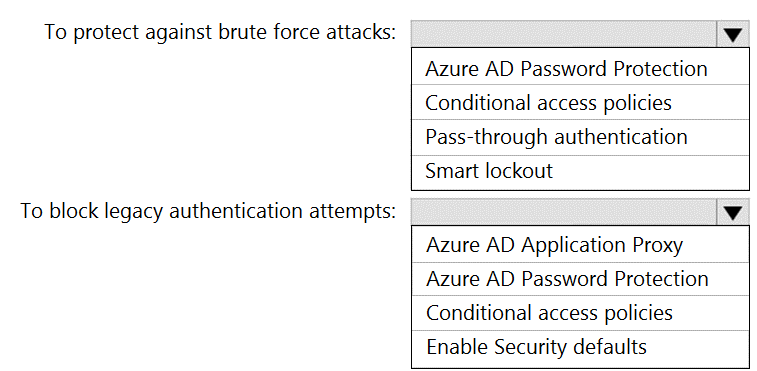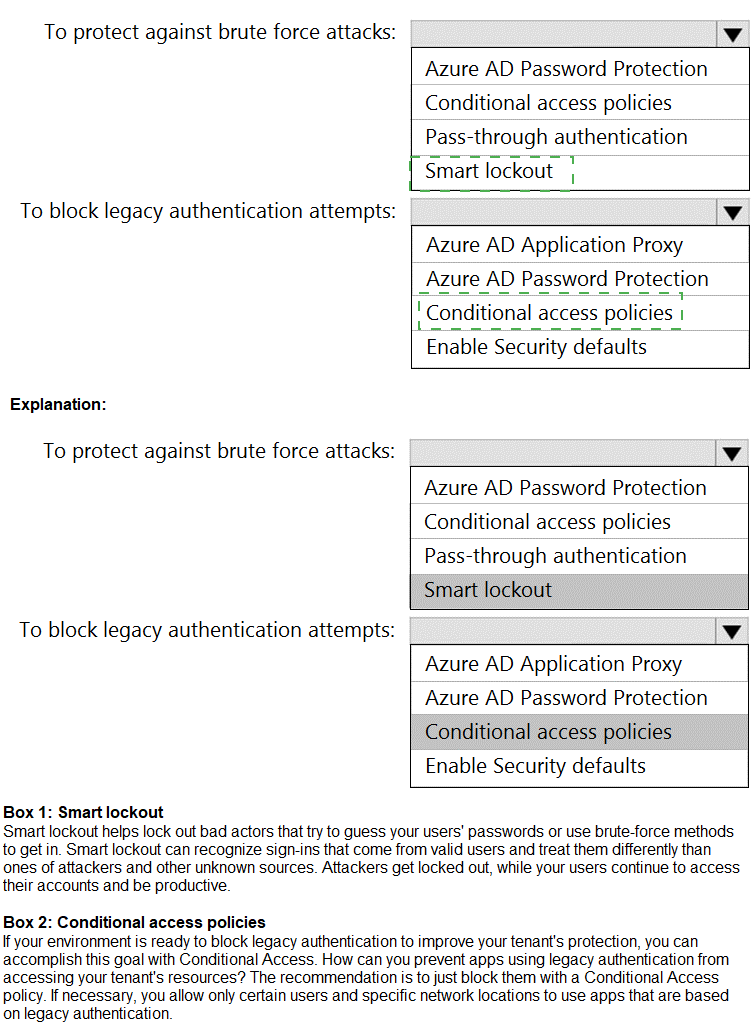
- Email support@dumps4free.com

Topic 5: Misc. Questions
You have the Free edition of a hybrid Azure Active Directory (Azure AD) tenant. The tenant uses password hash synchronization.
You need to recommend a solution to meet the following requirements:
Prevent Active Directory domain user accounts from being locked out as the result of brute force attacks targeting Azure AD user accounts.
Block legacy authentication attempts to Azure AD integrated apps.
Minimize costs.
What should you recommend for each requirement? To answer, select the appropriate options in the answer area.
NOTE: Each correct selection is worth one point.


Note: This question is part of a series of questions that present the same scenario. Each question in the series contains a unique solution that might meet the stated goals. Some question sets might have more than one correct solution, while others might not have a correct solution.
After you answer a question in this section, you will NOT be able to return to it. As a result, these questions will not appear in the review screen.
Your company plans to deploy various Azure App Service instances that will use Azure SQL databases. The App Service instances will be deployed at the same time as the Azure SQL databases.
The company has a regulatory requirement to deploy the App Service instances only to specific Azure regions. The resources for the App Service instances must reside in the same region.
You need to recommend a solution to meet the regulatory requirement.
Solution: You recommend creating resource groups based on locations and implementing resource locks on the resource groups.
Does this meet the goal?
A.
Yes
B.
No
No
Explanation:
Resource locks are not used for compliance purposes. Resource locks prevent changes from being made to resources.
Reference:
https://docs.microsoft.com/en-us/azure/azure-resource-manager/management/lockresources
You need to design a highly available Azure SQL database that meets the following requirements:
* Failover between replicas of the database must occur without any data loss.
* The database must remain available in the event of a zone outage.
* Costs must be minimized.
Which deployment option should you use?
A.
Azure SQL Database Business Critical
B.
Azure SQL Database Managed Instance Business Critical
C.
Azure SQL Database Serverless
D.
Azure SQL Database Premium
Azure SQL Database Premium
Explanation: General Purpose / Standard prevents data loss through high available storage https://docs.microsoft.com/en-us/azure/azure-sql/database/service-tier-generalpurpose?view=azuresql. This architectural model relies on high availability and reliability of Azure Blob storage that transparently replicates database files and guarantees no data loss if underlying infrastructure failure happens. General Purpose / Standard support Zone Redundancy For General Purpose tier the zone-redundant configuration is Generally Available in the following regions: https://docs.microsoft.com/en-us/azure/azuresql/database/high-availability-sla?view=azuresql&tabs=azure-powershell Without any information regarding the usage pattern, serverless is possible. Other option is D.
https://docs.microsoft.com/en-us/azure/azure-sql/database/serverless-tieroverview?view=azuresql
You are designing a message application that will run on an on-premises Ubuntu virtual machine. The application will use Azure Storage queues.
You need to recommend a processing solution for the application to interact with the storage queues. The solution must meet the following requirements:
Create and delete queues daily.
Be scheduled by using a CRON job.
Upload messages every five minutes.
What should developers use to interact with the queues?
A.
Azure CLI
B.
AzCopy
C.
Azure Data Factory
D.
.NET Core
.NET Core
You have an Azure subscription.
You need to recommend a solution to provide developers with the ability to provision Azure virtual machines. The solution must meet the following requirements:
• Only allow the creation of the virtual machines in specific regions.
• Only allow the creation of specific sizes of virtual machines.
What should you include in the recommendation?
A.
Conditional Access policies
B.
role-based access control (RBAC)
C.
Azure Resource Manager (ARM) templates
D.
Azure Policy
role-based access control (RBAC)
Explanation: https://docs.microsoft.com/en-us/azure/governance/policy/tutorials/createand-manage
https://docs.microsoft.com/en-us/azure/cloud-adoption-framework/manage/azure-servermanagement/common-policies#restrict-vm-size
| Page 10 out of 56 Pages |
| Previous |